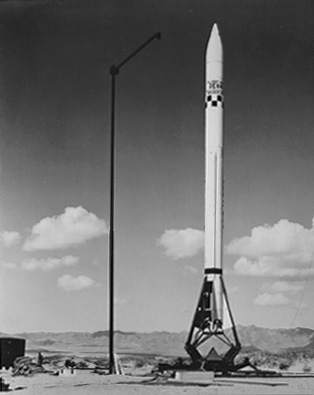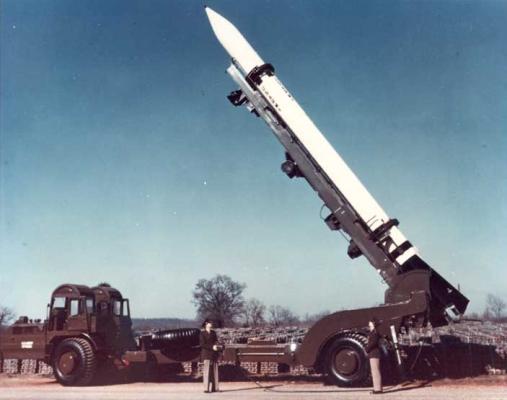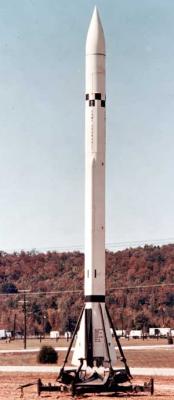JPL/Firestone SSM-A-17/M2/MGM-5 Corporal
The Corporal was the first U.S. guided missile system to be approved for nuclear armament, and the first operational guided missile of the U.S. Army. It evolved from a series of Army research rockets begun in 1944/45.
The first missile to carry the name Corporal was the small WAC Corporal (designated RTV-G-1 in 1947) sounding rocket, first launched in September 1945. The WAC Corporal B was later also used to create an experimental two-stage research rocket, when it was mounted on top of captured German V-2 missiles. 8 of these vehicles, known as RTV-G-4 Bumper, were used for tests between 1948 and 1950.
The immediate forerunner of the tactical Corporal SSM was the RTV-G-2 Corporal E surface-to-surface test vehicle. It was first flown in May 1947. The Corporal E was used to evaluate basic principles of ballistic guided missile construction, flight, and guidance. Because the Hermes program would need more time to lead to an operational missile, it was decided in 1950 to develop the Corporal E into a tactical nuclear-armed ballistic missile, designated SSM-G-17 Corporal. In 1951, the Army's missile designation system changed slightly, and the RTV-G-2 and SSM-G-17 became RV-A-2 and SSM-A-17, respectively. However, the RV-A-2 designation was dropped almost at the same time, and all Corporal test rounds were known as XSSM-A-17.
Main contractor for Corporal was the Jet Propulsion Laboratory (JPL), and the early Corporal E missile airframes were built by Douglas. However, the contract for the production of the operational missiles went to Firestone in 1951, after missile design had been frozen. The first tactical SSM-A-17 Corporal version was also known as Corporal Type I. The first flight occurred in August 1952, and in April 1954 the first Army units began training with the missile, which was designated as Guided Missile XM2 in service. The SSM-A-17 was armed with a W-7 nuclear fission warhead (20 kT).
 |
 | |
| Photos: U.S. Army | ||
| RTV-G-2 | SSM-A-17 | |
The SSM-A-17 Corporal had many inherent problems, some of which resulted from it being essentially a slightly modified research missile. Its JPL liquid fueled rocket motor was not only rather complex and unreliable, but also used red fuming nitric acid (RFNA) as oxidizer. RFNA is a highly toxic and corrosive substance, and fueling was a very dangerous process. The other major problem was the guidance system. The missile's trajectory and velocity was tracked by a ground radar (a modified SCR-584 designated AN/MPQ-12), which computed necessary course corrections, which were transmitted to the missile's autopilot. The missile was steered in flight by rudders and jet vanes, and range was controlled by sending a motor shut-off command at the appropriate time. This guidance system was very complex and hard to maintain, and also prone to electronic jamming. All these problems resulted in a less than 50% reliability of the Corporal missile system. Furthermore, a Corporal battalion consisted of about 35 vehicles, and was rather cumbersome to move. After a launch site had been reached, it took around 9 hours before the first missile could be fired.
In 1953, JPL started to look for improvement of the Corporal's reliability. The major changes in the new system (called Corporal Type II) were new radar/radio components, including a new Doppler unit. The missile launcher, erector, and servicing platform were also redesigned. The Type II missiles were initially known as XSSM-A-17a, and later as XM2E1. Beginning in 1956, Type II quickly replaced all Type I systems, and the Corporal missile was designated as Guided Missile, Artillery M2.
Type IIa, introduced in 1957, had an improved guidance system, which changed much of the system's electronic components, but resulted in no external changes to the missile. From 1958, production missiles were of Type IIb, which had an air-turbine alternator (ATA) instead of the unreliable internal batteries, and quick-disconnect fins for faster missile setup. The Type IIb missiles were designated as M2A1 (it is possible, but not likely, that the M2A1 designation also applied to the Type IIa missiles). Although the Corporal Type II/IIa/IIb somewhat improved the system's reliability, the basic problems of the Corporal remained.
 |
 | |
| Photos: U.S. Army | ||
| M2 (MGM-5A/B) (exact model unknown) | ||
The Army originally planned to develop a Corporal Type III missile with a further improved guidance system, but in 1958 this was cancelled, because development of the much more advanced MGM-29 Sergeant made good progress. After the Sergeant became operational in 1962, the Corporal was quickly phased out, and the last Corporal was retired in 1964. In 1963, the M2 and M2A1 missiles had been redesignated as MGM-5A and MGM-5B, respectively. About 1100 Corporal Type I, II, IIa and IIb missiles were delivered to the U.S. Army.
Specifications
Note: Data given by several sources show slight variations. Figures given below may therefore be inaccurate!
Data for RTV-G-2 (RV-A-2), M2/M2A1 (MGM-5A/B):
| RTV-G-2 (RV-A-2) | M2/M2A1 (MGM-5A/B) | |
|---|---|---|
| Length | 12.1 m (39 ft 8 in) | 13.8 m (45 ft 4 in) |
| Finspan | 2.7 m (8 ft 9 in) | 2.1 m (7 ft) |
| Diameter | 0.76 m (30 in) | |
| Weight | 4200 kg (9250 lb) | 5000 kg (11000 lb) |
| Speed | 3300 km/h (2050 mph) | 3500 km/h (2200 mph) |
| Ceiling | ? | 40 km (25 miles) |
| Range | 100 km (62 miles) | Min: 48 km (30 miles); Max: 130 km (80 miles) |
| Propulsion | JPL liquid-fueled rocket motor; 89 kN (20000 lb) for 60 s | JPL liquid-fueled rocket motor; 89 kN (20000 lb) for up to 64 s |
| Warhead | none | W-7 nuclear fission (20 kT) |
Main Sources
[1] James N. Gibson: "Nuclear Weapons of the United States", Schiffer Publishing Ltd, 1996
[2] Bill Gunston: "The Illustrated Encyclopedia of Rockets and Missiles", Salamander Books Ltd, 1979
[3] Redstone Arsenal Historical Information Website
Back to Current Designations Of U.S. Unmanned Military Aerospace Vehicles
Back to
Directory of U.S. Military Rockets and Missiles
Last Updated: 30 January 2003